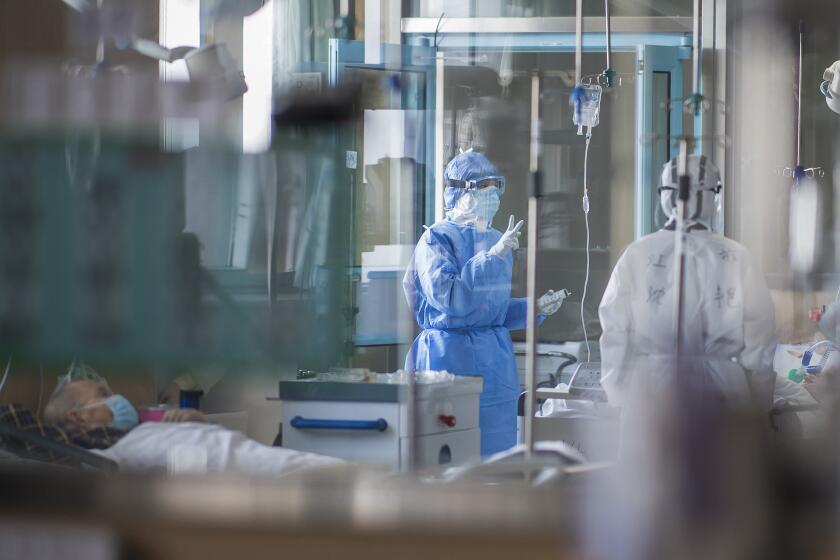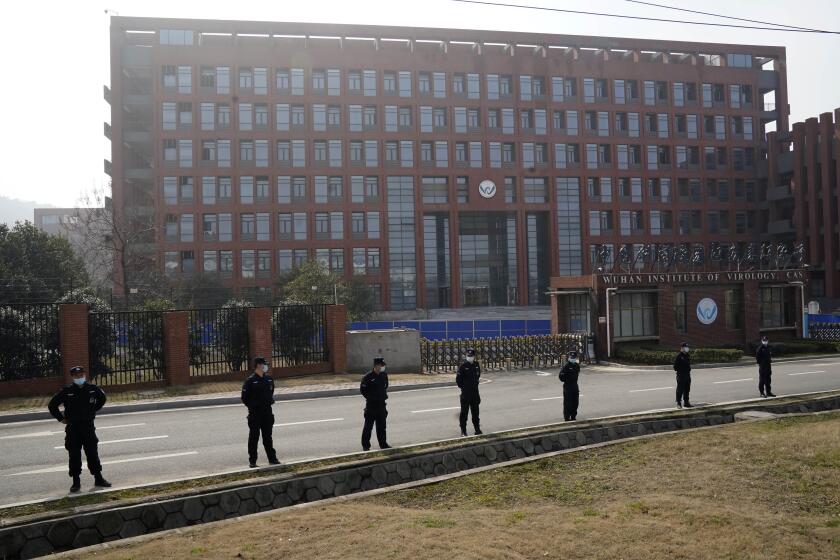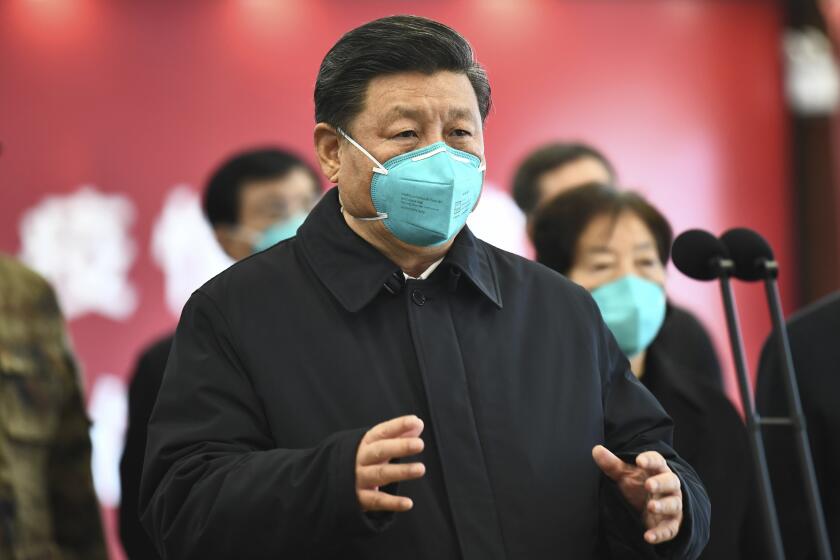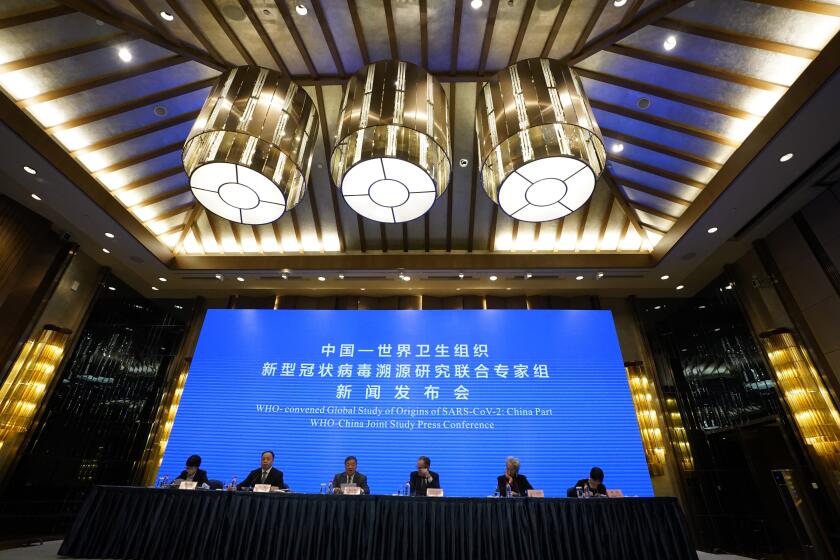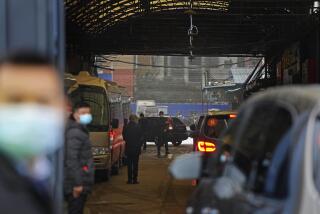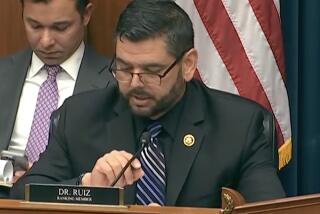Fresh look at earliest COVID cases points to live-animal market as most likely source

- Share via
Conspiracy theorists need little more than suspicion, some cherry-picked facts and vibrant imaginations to spin tales about the origins of the COVID-19 pandemic. But for the scientists working to establish the facts, the path to the truth is much more plodding.
Their search will take them through a trove of medical records whose quotidian details will be important guideposts to the time and circumstances of the coronavirus’ birth as a human pathogen. Patients’ recall of their whereabouts and contacts will matter too.
But even if the Chinese government were willing to open all its patient files to international investigators — it currently is not — symptom reports and patients’ memories can be fallible and confusing. Researchers need to check every fact as they ferret out the story, piece by piece.
University of Arizona evolutionary biologist Michael Worobey offers a down payment on such sleuthing in this week’s edition of the journal Science. Drawn from medical journal articles, the work of World Health Organization investigators, media reports and online accounts, Worobey’s reconstruction leaves many questions unanswered. But it provides a road map for further investigation.
Worobey has played an influential role. He was one of 18 scientists whose objections to a WHO report on the coronavirus’ origins reignited investigation into the possibility that it might have leaked from the Wuhan Institute of Virology.
Their letter was published in Science after the WHO declared it “likely to very likely” that the virus jumped to humans from animals, and “extremely unlikely” that it escaped from the government lab. Noting that the two theories “were not given balanced consideration,” the group called for “a proper investigation” to resolve the issue.
Worobey said at the time that “both” explanations “remain on the table for me.” But his new work leans heavily to the “animal spillover” explanation.
A timeline of COVID-19’s early weeks in China, beginning with the emergence of the first patient on or around Nov. 18.
Worobey’s effort is meeting with mixed reviews.
“I don’t think this advances in a major way our collective understanding of what really happened,” said Dr. David Relman, the Stanford microbiologist who organized the Science letter. Since Worobey’s new narrative is constructed mainly of “third- and fourth-hand information,” it is fragmentary, inconsistent and potentially unreliable, Relman said.
But Scripps Institution microbiologist Kristian Andersen, who has long argued that an animal spillover was more likely than a lab leak, lauded Worobey’s research for “uncovering several new key insights.”
The collective evidence “clearly points to the Huanan Market as a very likely source of the origin of the COVID-19 pandemic,” Andersen said.
Worobey’s account calls into question the date and location of the earliest reported case of the mysterious type of pneumonia that was later recognized as COVID-19. His research suggests it was not — as has been widely reported — a 41-year-old accountant with no connection to the Huanan Market, but a seafood vendor who worked there. (A Chinese investigative reporter would discover that the accountant’s Dec. 8 fever was due to an infection after dental surgery to remove retained baby teeth. The accountant would go on to develop another fever eight days later that was a sign of COVID-19.)
A full 11 days before Chinese authorities focused their attention on the Huanan Market as the common link in the mysterious infections, doctors at two Wuhan hospitals had already identified 14 cases of the unexplained pneumonia. Eight of those patients had spent time at the market, where live raccoon dogs, a species known to carry SARS-like coronaviruses, were sold.
Scientists are urging their colleagues to dig deeper into the origins of the coronavirus behind the pandemic, including the possibility of a lab escape.
The significance of such minute details would not be evident to casual followers of the origin debate. But they matter enormously.
Those arguing that China has covered up an accidental lab leak or the intentional release of an engineered pathogen have seized upon this finding in the WHO report: Only 33% of 168 patients who developed the unexplained pneumonia early in the outbreak had a direct link to the Huanan Market. They add that even that number is likely inflated by doctors who went looking for links to the market after Chinese authorities designated the site as the likely source.
They’ve also made much of the now-disputed report that the earliest known patient (the 41-year-old accountant) lived nearly 20 miles south of the Huanan Market and had never been there, yet he showed up sick in a hospital close to the Wuhan Institute of Virology.
Dr. Marc Suchard, a UCLA researcher who uses genetic sequences to study the spread of disease, said Worobey’s reconstruction makes clear that “most early cases occur near the market, identifying it as an early epicenter.” Suchard said he expects to work with Worobey on the next phase of this research.
China insists the SARS-CoV-2 virus arose from a spillover event. Authorities there said they responded promptly to reports of an unexplained illness in Wuhan, quickly tracing it to the Huanan Market and activating a national warning system.
They dismiss the possibility that the virus escaped from the Wuhan virology lab. But they’ve been unwilling to share their records with WHO investigators. And because the government has covered up missteps in past disasters, skepticism of its claims has been widespread.
For more than a year, debate about the origins of the virus has been deeply political. Biden returned it to the realm of science.
Worobey did not acknowledge the politically charged debate over the virus’ origins. But he made clear his reconstruction of events points strongly toward a spillover explanation.
For instance, by his accounting, 10 of the 19 earliest cases identified — 53% — had a link to the market. That number could not have been inflated by doctors’ following the government’s lead, he said, because they were all identified before authorities made any announcement.
“There was a genuine preponderance of early COVID-19 cases associated with Huanan Market,” Worobey wrote.
He also wrote that, given what is now known about the SARS-CoV-2 virus, it should be no surprise that many of the early patients had no connection to the Huanan Market. The virus is easily spread by people with few or no symptoms. It takes close to two weeks for an infection to progress to severe illness, and no more than 7% of those infected end up hospitalized.
That means by the time people began to land in Wuhan’s hospitals, the virus had probably been circulating locally for weeks — and at least 93% of infected people were out and about, able to spread it in a city of 11 million.
Among patients with no direct link to the market, most lived close by. That “is notable and provides compelling evidence that community transmission started at the market,” Worobey wrote.
Those facts also suggest that the pandemic’s “patient zero” will likely never be found.
Understanding the origins of SARS-CoV-2, the virus that causes COVID-19, is a linchpin for future pandemic prevention.
Sometime in late November or early December, that person might have been eating lunch next to infected raccoon dogs in their cages at the Huanan Market. He or she might have been one of the nearly 50% of people who don’t feel very sick but are still quite effective at passing SARS-CoV-2 on.
The animal that incubated the virus is even less likely to be found. Chinese researchers told WHO investigators they took samples from 188 animals from 18 species at the market, and all tested negative. And since the market was closed and disinfected on Jan. 1, 2020, there’s no way to look further.
So researchers will have to keep collecting epidemiological data and sorting through the telling details to create the fullest picture possible of the virus’ birth.
Genetic sequencing data can also help, Worobey said. As the virus moves from person to person, its genetic signature changes just enough to reveal the order in which infections occurred. When epidemiologists and geneticists pool their data, they’re better able to create a family tree of infections.
As they cross-check genetic signatures with patients’ accounts of their contacts and whereabouts, they may be able to time-stamp some infections and discern the spatial patterns of the virus’s earliest transmissions. That should get them closer to the root of the family tree — maybe not patient zero, but close.
“Conclusive evidence of a Huanan Market origin from infected wildlife may nonetheless be obtainable,” Worobey wrote. “Preventing future pandemics depends on this effort.”
